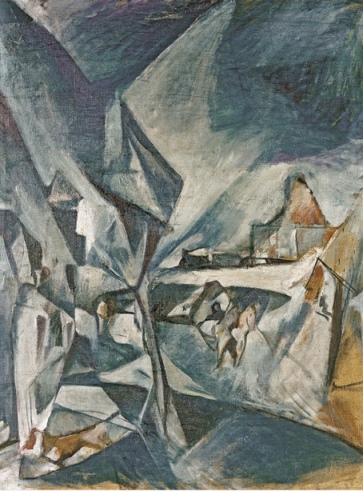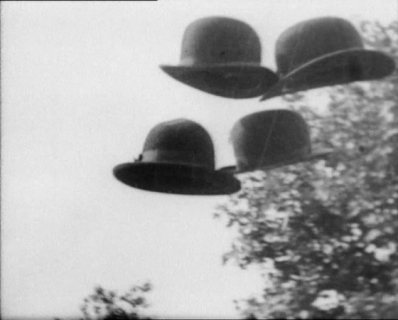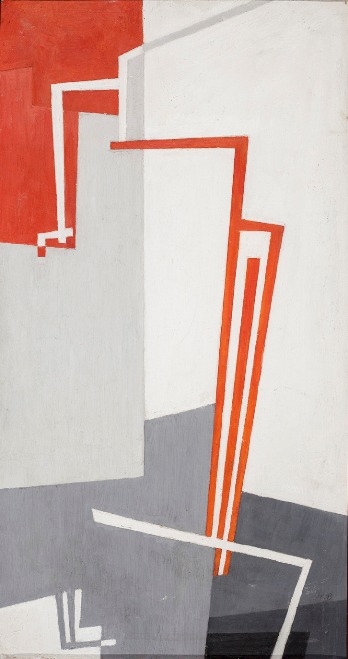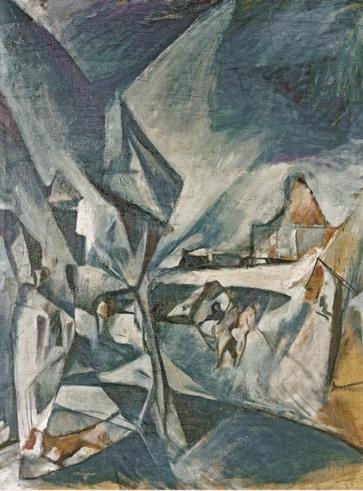The versatile and multiply talented Hans Richter--whose exhibition opens on Sunday (and to members today)--was equally at home as a painter, filmmaker, and writer, helping to bring about groundbreaking advances from Expressionism and Dadaism to Constructivism and Surrealism to experimental and avant-garde film. For Richter, whose Rhythmus 21 and Rhythmus 23 are among the first abstract films ever created, the future of art and film were one and the same.
Richter’s life and creativity brought him into contact with a virtual Who’s Who of early twentieth-century pioneers, many of whom we include in the exhibition: Hans Arp, Marcel Duchamp, Max Ernst, El Lissitzky, Kazimir Malevich, Man Ray, László Moholy-Nagy, Sophie Taeuber-Arp, and many others. When driven out of Germany by the Nazi regime, Richter eventually made his way to New York, where he taught film at City College and became engaged with the émigré artists’ community as well as the pioneers of New American Cinema, including Jonas Mekas, Stan Brakhage, Maya Deren, and Standish Lawder, among many others.
 Hans Richter, Schlittenfahrt (Skating), c. 1915, Kunsthaus Zürich, © 2013 Hans Richter Estate, Photo: Kunsthaus Zürich
Hans Richter, Schlittenfahrt (Skating), c. 1915, Kunsthaus Zürich, © 2013 Hans Richter Estate, Photo: Kunsthaus Zürich
The social import and utopian outlook of Richter’s art is a legacy of his first encounters with the avant-garde through artists and intellectuals associated with the leading Berlin artistic circles of the 1910s where he experienced both Cubism and the Expressionist Blaue Reiter aesthetic. For Richter, the Cubists brought not only “a new sense of harmony . . . a quiet, more powerful music” but also “the courage, the audacity to dare this step. They jumped from the world of natural objects into the fragmentation of objects, so I jumped too.” Simultaneously he fell in with the pacifist and anarchist crowd around the periodical Die Aktion (The Action), whose contributors he described as an assortment of “expressionists . . . , socialists, Tolstoyists, cubists, poets, and politicians.” The strong sense of social conscience Richter gained from his engagement with these creative circles was intensified by his experience in World War I. Seriously injured within a month of his induction in September 1914, Richter was eventually discharged from active duty and in 1916 made his way to Zürich’s Café de la Terrasse to keep an appointment with two Expressionist poets he had made partially in jest two years earlier on the eve of his induction. Suddenly he found himself in the midst of the most radical artists’ group in Europe at the time, Zürich Dada, whose members included Hans Arp, Marcel Janco, Sophie Taeuber-Arp, and Tristan Tzara.
While taking part in the Dadaists’ exhibitions, Richter experienced abstraction in its purest form in the abstract embroideries by Adya van Rees and Sophie Taeuber-Arp. Taeuber-Arp’s abstract works influenced Richter’s paintings and films, but equally as important, in her search for “principles of order” she shared, along with Hans Arp’s “enchanted” language, a purpose for art similar to Richter’s pursuit in collaboration with Swedish artist Viking Eggeling of a “universal language” that could bring all of humanity together.
Richter and Eggeling began with abstract drawings and paintings based on musical analogs: Richter was inspired by a suggestion from Italian composer Ferruccio Busoni to try counterpoint, “movement and counter-movement. So then I used the paper like a musical instrument.” Richter began making scrolls, including Orchestration der Farben (Orchestration of Colors), 1923/1970, which convey an ambiguous space in which forms seem to move through time. The next step came with a joint decision by Richter and Eggeling that their sequential forms were best suited to the film medium, and Richter evolved a revolutionary idiom over the course of his films Rhythmus 21 and Rhythmus 23, in which the very elements of cinema (the screen, the presence, and absence of light) allow the screen to represent nothing but itself, immersing the viewer in a single field where the work of art exists in a continuum between cinematic and architectural space, as seen in LACMA’s exhibition.
 Hans Richter, Vormittagsspuk/Ghosts Before Breakfast, 1928, © Hans Richter Estate
Hans Richter, Vormittagsspuk/Ghosts Before Breakfast, 1928, © Hans Richter Estate
On the occasion of the Baden-Baden Music Festival in 1928, Richter presented his film Vormittagsspuk (Ghosts before Breakfast) with music by Paul Hindemith. Over the next few years Richter was deeply involved in film and even acted as a film curator for the now famous 1929 FiFo (Film and Foto) exhibition in Stuttgart. This was one of the first exhibitions to bring film and photography together in an aesthetic called “New Vision.” Hans Richter: Encounters includes photographs by Karl Blossfeldt, Anton Bruehl, Imogen Cunningham, Florence Henri, André Kertész, Man Ray, László Moholy-Nagy, Werner Rohde, Maurice Tabard, Umbo, and Edward Weston, a number of these from the Audrey and Sydney Irmas Collection and the Marjorie and Leonard Vernon Collection at LACMA. After a decade of making industrial and commissioned films in Holland and Switzerland, Richter managed to escape the increasingly desperate conditions for Jews in Europe and arrived in New York in 1941. Upon his arrival, Richter reflected on the events in Europe in monumental scrolls that treated epic moments from the war, combining painting and collage techniques.
Gesture was an equal starting point for his films and his paintings, as Richter made clear in a remarkable scrapbook of 1942. In this sequence of more than one hundred drawings (made available to the visitor digitally in the exhibition), Richter explains his working process for creating the painting Dragonfly (Counterpoint in Red, Black, Gray, and White), 1943.
 Hans Richter, Dragonfly (Counterpoint in Red, Black, Gray, and White), 1943, private collection, © 2013 Hans Richter Estate, Photo © 2013 Museum Associates/LACMA
Hans Richter, Dragonfly (Counterpoint in Red, Black, Gray, and White), 1943, private collection, © 2013 Hans Richter Estate, Photo © 2013 Museum Associates/LACMA
Throughout the exhibition we see how Richter transported forms or procedures between artistic media. He achieved spectacular results in his American films, and especially in Dreams that Money Can Buy (1944–47), an enchanting film made in collaboration with John Cage, Alexander Calder, Marcel Duchamp, Max Ernst, Fernand Léger, Darius Milhaud, and Man Ray (among others), shown in a special theater within the exhibition. Ever the Dadaist, Richter kept up with the new generation of neo-Dada, pop, neorealist, and Fluxus artists, making his own multiples and Dada-redux pieces and greeting the next generation with the hope “that art’s original magic will be brought to life again.”
Timothy O. Benson, Curator of the Rifkind Center for German Expressionist Studies at LACMA
Hans Richter: Encounters opens this Sunday. Member previews are open Thursday through Saturday.
On Sunday afternoon, LACMA is presenting a free screening of the new documentary Hans Richter: Everything Turns -- Everything Revolves, followed by a Q&A with the film's director, David Davidson.



